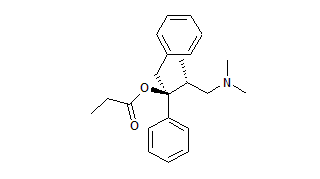Tramadol hydrochloride is a weak opioid with effects on seratoninergic and adrenergic neurotransmission.[1] It is reported to have fewer opioid adverse effects than conventional opioid analgesia.[2] We report an unusual but important adverse effect not previously reported with the drug.
Case report
A 74 year old man with lung cancer was referred to the palliative care team for symptom control. He had pain in the left side of his chest and was advised to take tramadol hydrochloride 50 mg four times daily at home. Soon after starting the tramadol, he began to experience auditory hallucinations. These were particularly vivid and took the form of "two voices singing, accompanied by an accordion and a banjo, singing songs, songs by Josef Locke--old songs." They were distressing, making him feel as though he was going mad. Because of these symptoms we admitted the patient for inpatient care.
He was also taking aspirin 75 mg, digoxin 250 [micro]g, prednisolone 15 mg, frusemide 40 mg, omeprazole 20 mg, and codanthramer 20 ml, each once daily, and Voltarol 75 mg twice daily, and he was using a Combivent (salbutamol/ipratropium) nebuliser 2.5 ml four times daily, but all these had been unchanged for some weeks before the onset of the auditory hallucinations. The patient had no other adverse effects or signs of toxicity attributable to opioids.
We discontinued the tramadol and instead gave two tablets of co-proxamol (dextropropoxyphene 32.5 mg, paracetamol 325 mg) four times daily, with which his cancer pain was well controlled. Two days later the hallucinations ceased. A computed tomographic brain scan around the time of admission showed only established diffuse ischaemic change with no major focal cerebral lesion. There was no history of hallucinations or mental illness. We reported this adverse reaction to the Committee on Safety of Medicines through the yellow card scheme.
Discussion
Tramadol is a centrally acting opioid analgesic which has been available in the United Kingdom since 1994 and is licensed for use orally or by injection for the treatment of moderate to severe pain.[3] Experience of the use of this drug in Britain is limited, although it has been available for some years in Germany. Reported adverse effects have included nausea, drowsiness, dry mouth, sweating, dizziness, muzziness, trembling, and sedation.[4] Auditory hallucinations have been reported in association with pentoxifylline[5] and doxazosin.[6]
Musical hallucinations are well described in elderly people, though predominantly in women or in those with depression or hearing impairment.[7] In the absence of these other possible causes and with a clear temporal relation to the administration of tramadol, we conclude that the tramadol was the cause of the hallucinations.
Competing interests: None declared.
[1] Lee CR, McTavish D, Sorkin EM. Tramadol. A preliminary review of its pharmacodynamic and pharmacokinetic properties, and therapeutic potential in acute and chronic pain states. Drugs 1993;46:313-40.
[2] Medicines Control Agency, Committee on Satety of Medicines. In focus: tramadol. Curr Probl Pharmacovigilance 1996;22:11.
[3] Tramadol--a new analgesic. Drug Ther Bull 1994;32:85-7.
[4] Budd K. Chronic pain--the challenge and the response. Drugs 1994;47:33-8.
[5] Gilbert GJ. Pentoxifylline-induced musical hallucinations. Neurology. 1993;43:1621-2.
[6] Evans M, Perera PW, Donoghue J. Drug induced psychosis with doxazosin. BMJ 1997;314:1869.
[7] Pasquini F, Cole MG. Idiopathic musical hallucinations in the elderly. J Geriatr Psychiatry Neurol 1997;10:11-4.
Strathcarron Hospice, Denny, Stirlingshire FK6 5HJ
Paul W Keeley specialist registrar
Gillian Foster hospice physician
Lesley Whitelaw specialist palliative home care sister
Correspondence to: P W Keeley Paulkeeley@ hotmail.com
BMJ 2000;321:1608
COPYRIGHT 2000 British Medical Association
COPYRIGHT 2001 Gale Group



